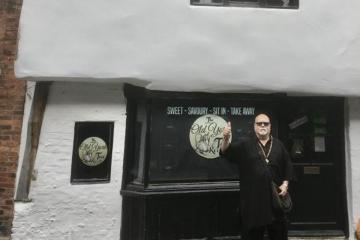The relentless pursuit of urban aesthetic and historical preservation often brings forth curious juxtapositions. A recent focus on a seemingly minor signage issue in York has now sparked a broader conversation, with community voices urging a well-known heritage campaigner to direct his considerable energy towards more significant challenges facing the city’s modern landscape. This narrative underscores the ongoing tension between preserving historical integrity and accommodating contemporary urban development and the importance of community activism.
Gordon Campbell Thomas, a familiar figure in York’s heritage circles, recently garnered attention for his successful campaign to remove a “harmless” sign from The Old York Tea Rooms. While this act highlighted his dedication to protecting the city’s visual character, critics suggest such isolated victories may distract from larger, more systemic issues impacting York’s unique heritage and complex urban planning.
The spotlight is now firmly on Spark York, a controversial development characterized by a collection of unsightly shipping containers located in a prominent city area. These temporary structures, initially permitted under strict conditions for a limited period, have now overstayed their welcome by five years, transforming a supposed interim solution into a long-standing urban blight that draws significant public ire.
From their very inception, the Spark York containers were recognized as being in direct contravention of established planning policies and incompatible with surrounding residential areas. Despite these clear red flags, they were controversially allowed to proceed, under the specific condition of a limited three-year tenure, a condition that has been conspicuously ignored for years. This ongoing breach raises serious questions about local governance and adherence to regulations impacting urban planning.
Notably absent from the public outcry against these protracted planning violations is Mr. Campbell Thomas. His previous zealous protests, often involving a distinctive cardboard sign, have not materialized against the backdrop of clear breaches of both local and national planning policies, including specific concerns regarding Section 72 of the 1990 Planning Act. This silence has prompted some to question the selective nature of community activism in heritage matters.
Adding a touch of local folklore to the discourse, anecdotal reports even suggested the “Ghost of William Etty,” a playful moniker often associated with Mr. Campbell Thomas, made an appearance during a recent makeover of The Old York Tea Rooms. Such tales illustrate the community’s keen observation of local figures and their impact on the urban fabric of York, particularly regarding heritage preservation.
The persistent presence of the Spark shipping containers represents more than just an aesthetic issue; it embodies a broader challenge to urban planning integrity. It highlights the critical need for consistent enforcement of planning regulations and a transparent process for addressing non-compliance, ensuring that temporary solutions do not become permanent problems that undermine community trust and local heritage in York.
The ongoing debate surrounding Spark York and the role of heritage campaigners like Mr. Campbell Thomas underscores a pivotal moment for the city. It serves as a potent reminder that true heritage protection extends beyond individual signs to encompass the broader architectural integrity and livability of the entire urban environment, calling for renewed focus on significant, long-term planning issues and sustained community activism.






Leave a Reply